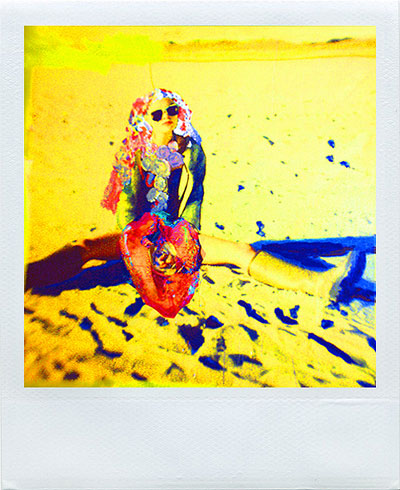Bianca D’Amico’s Sheela’s Gig is inspired by the artist’s encounter with the Sheela Na Gigs, medieval figurative carvings of naked women with exaggerated vulvas that were recently discovered in Churches in England and Ireland. Although the use and importance of these figures remain unresolved, some theorists have suggested that they are fertility symbols, while others believe that they express contempt of female sexuality.[1] Female sexuality has long been a subject of great taboo. Only during the last 50 years has female sexuality even been considered an acceptable topic of conversation. On one hand, popular media has frequently portrayed the sexually empowered female as a slut, while on the other hand, the women’s movement has had the effect of making the debate over female sexuality very serious and academically based. As a result of the academic nature of the debate, many people are not being involved in the discussion. In attempts to remedy this problem, the Sheela’s Gig installation takes a playful approach to female sexuality. In its playfulness, Sheela’s Gig makes the debate over female sexuality less serious and, therefore, allows the sexually empowered female to exist without as much scrutiny. Furthermore the debate about female sexuality becomes more accessible through her art because the discussion is not so academically oriented. In regards to the lighthearted nature of her investigation D’Amico writes, "When first discovering the Sheelas I was thrilled by the carvings' contortionist abilities and aggressive yet welcoming pose. The combination of their opening vulvas and the possibilities surrounding their signification felt to me like the perfect invitation - an 'open door' to jump into. An invitation to befriend, extend or create a contemporary narrative for these carvings. My work deals with notions of feminism and the Sheelas have allowed me to visually reflect my emphasis on female sexuality and pleasure in a subversive yet playful way. They're partners in crime, parading their sexual parts in a happy marriage with all the other characters in my art world."[2]
Aesthetically, the installation recalls the humorous hyper-sexualization of works by Jeff Koons, 1970’s female video artists such as Dara Birnbaum, and the aggressive brushstrokes and bright colors of De Kooning’s Woman series. However, with regards to De Kooning, D’Amico’s content differs from his aggressively sexualized women, which are congruent with the modern man’s fears of a liberated female sexuality. D’Amico’s female forms do not pander to man’s fear of the sexualized woman but rather facilitate a wider acceptance of the post-millennium woman’s right to sexual pleasure. Her celebration of female sexuality refutes and erodes the negative connotation associated with the popular notion of the sexualized female as promiscuous.
The content of D’Amico’s art is very similar to some of the more sexualized works of Jeff Koons such as his early 1990’s series of erotic images produced with then-wife Ilona. Like Koons, she relies on the kitsch, everyday objects, to present a work that is both sensational but also decidedly more accessible to a greater diversity of people. Unlike Koons, D’Amico incorporates nature into her work. For example, the Sheela’s Gig installation includes a rather large painting of a nude female whose genitalia are articulated by real plants. The connection is clear: sexuality is natural. While her articulation is somewhat different from Koons the message is similar: to deny sexuality is to deny life.  Jeff Koons, Ilona on Top
Jeff Koons, Ilona on Top Jeff Koons, Woman with Dolphin and Monkey
Jeff Koons, Woman with Dolphin and Monkey
 Jeff Koons, Ilona on Top
Jeff Koons, Ilona on Top Jeff Koons, Woman with Dolphin and Monkey
Jeff Koons, Woman with Dolphin and Monkey There is also a video component to the installation that recalls Dira Birnbaum’s Technology/Transformation: Wonder Woman. Situated between the legs of the large painted female is a box containing video images, balls of yarn, and pieces of wood. The video resembles an erotic workout video on acid. In the video one woman is bent over while the other is thrusting an attached penis behind her. The notion of a woman thrusting an artificial penis is subversive because it refutes man’s sexual power while the bright colors oversaturated colors reaffirm the prominence of media in contemporary society. Although there is a distinct critical element to the video, the colors are meant to amuse and the imagery is meant to be humorous. Birnbaum’s film emphasizes the exploitation of women’s bodies through repetition and the role of technology, the media, in defining gender roles. Similarly, D’Amico uses repetition and attention-grabbing colors to emphasize the media’s role in defining popular conceptions about female sexuality. D’Amico’s reversal of gender roles pokes fun at the media’s debasing portrayal of sexualized women as sluts while the sexualized man is regarded as somewhat of a heroic icon. Dira Birnbaum, "Technology/Transformation: Wonder Woman
Ultimately, the viewing of D’Amico’s work is fun and often hilarious much like the work of Koons; however, don’t write off D’Amico’s work as simply humorous or kitsch because within the work’s sensationalism the artist delivers a deft critique of repressed sexuality and the media’s role in defining the acceptable practices of sexuality. It is precisely the accessibility of D’Amico’s work that is so exciting because, like Koons, it invites a larger, more pedestrian audience to consider the complicated issues surrounding the taboo nature of female sexuality.

Bianca D'Amico, "Sheela's Gig"
 A Sheela Na Gig
A Sheela Na Gig Bianca D'Amico, Polaroid from "Sheela's Gig"
Bianca D'Amico, Polaroid from "Sheela's Gig" De Kooning's Woman on Bicycle
De Kooning's Woman on Bicycle
No comments:
Post a Comment